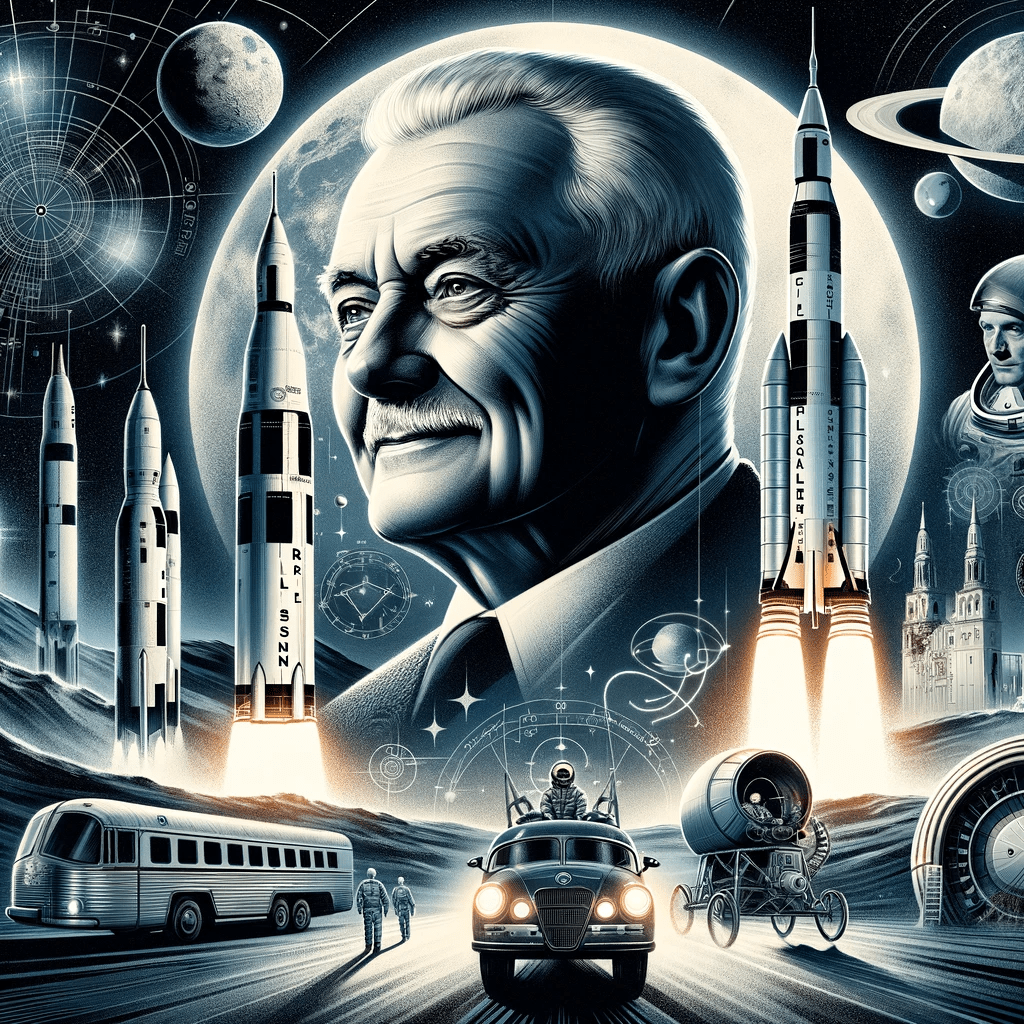Wernher von Braun

Wernher von Braun, known to many as the “Father of Rocket Science,” was a figure who, throughout his career, combined impressive engineering skill, relentless ambition, and a capacity for controversy. He was instrumental in developing the technological marvels that ushered in the Space Age, his legacy bridging two very different political systems and continents.
Von Braun was born on March 23, 1912, in Wirsitz, Germany. His educational background was diverse and extensive. As a young boy, he was given a telescope by his mother, sparking a fascination with the universe that would last his lifetime. He studied mechanical engineering and physics at the Technical University of Berlin, earning his doctorate in physics (aerospace engineering) in 1934. His doctoral thesis, a seminal work on rocket engines, was initially kept secret by the German army due to its military significance, demonstrating the dual-use potential of rocket technology from its earliest days.
In the 1930s and early 1940s, he led Germany’s V-2 rocket program, producing a weapon of terror and destruction used against the Allies during World War II. Yet, after the war, he was brought to the United States under Operation Paperclip, a secret program designed to recruit German scientists to aid the U.S. effort against the Soviet Union during the Cold War.
Von Braun, along with about 1,600 other German scientists, was offered contracts and brought to the United States. He arrived in the U.S. in September 1945 and was assigned to work at the U.S. Army’s Ordnance Corps testing grounds in White Sands, New Mexico, marking the start of his career in the U.S. space and missile program.
When Wernher von Braun was brought to the United States, the President was Harry S. Truman. Franklin D. Roosevelt was President during much of World War II, but he died in office in April 1945. Truman, then Vice President, assumed the presidency upon Roosevelt’s death. Truman was still in the early months of his presidency when Operation Paperclip, which brought von Braun and other German scientists to the U.S., was underway.
In the U.S., von Braun became a key figure in the development of the American space program. He headed the U.S. Army’s rocket development team and later became the director of NASA’s Marshall Space Flight Center, where he played a vital role in the design and development of the Saturn V rocket, which carried Apollo 11 to the moon in 1969.
- “Wernher von Braun, both in Europe and America, was not just a rocket engineer. He was one of the most politically savvy scientists of the 20th century.” (Source: Michael J. Neufeld, a von Braun biographer and a curator at the Smithsonian National Air and Space Museum, as cited by Smithsonian Magazine)
- “His contributions to the American space program were significant enough to earn him a place on the shortlist for Time magazine’s Man of the Year in 1969.” (Source: Time magazine archives)
- “Wernher von Braun predicted a ‘wheel-shaped’ space station well before its time.” (Source: ‘The Mars Project’, written by von Braun himself)
Experts such as Neil Armstrong, the first man on the moon, acknowledged von Braun’s significant contributions to the Apollo program. Michael J. Neufeld, who penned the comprehensive biography, “Von Braun: Dreamer of Space, Engineer of War,” offers an in-depth view of his life’s complex facets.
In 1952, he published “The Mars Project,” a technical specification for a manned expedition to Mars. He also co-wrote a popular science book with space science writer Willy Ley, titled “Conquest of the Moon.”
“The Mars Project” is an influential book by Wernher von Braun, first published in German in 1952 under the title “Das Marsprojekt,” and later translated into English. It was one of the earliest detailed scientific and technical studies on the feasibility of a manned mission to Mars.
In the book, von Braun proposed an ambitious plan for a manned mission to Mars that involved the development and construction of a fleet of 10 spacecraft, each capable of carrying a crew of 70. The mission would require a total of about 1,000 personnel, including astronauts, engineers, and support staff. The spacecraft would be assembled in Earth’s orbit using materials and components launched by reusable rockets.
Von Braun envisioned that the Mars-bound fleet would use a conjunction-class mission profile, a plan where a spacecraft takes a trajectory that allows it to arrive at Mars when the planet is at its closest approach to Earth. The fleet would remain on Mars for a period of over a year, waiting for the optimal launch window to return to Earth.
The book included detailed calculations and technical specifications, outlining the necessary propulsion systems, life support systems, and other technologies that would be needed to carry out the mission.
While many of von Braun’s ideas in “The Mars Project” were ahead of their time and technologically unfeasible in the 1950s, they have had a significant influence on subsequent thinking about manned Mars exploration. Some of the concepts von Braun proposed, such as in-orbit assembly of spacecraft and the use of reusable rockets, are now cornerstones of modern space exploration planning.
Despite the controversy surrounding his past, von Braun’s undeniable talents and leadership propelled him to become a central figure in the U.S. space program. His contribution to the development of the Saturn V rocket, the vehicle that propelled the Apollo missions, was pivotal. His influence even extended beyond his lifetime as his vision for a manned mission to Mars continues to inspire and shape current plans for interplanetary exploration.



